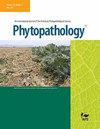Lilian A Okiro, Richard M Mulwa, Maurice E Oyoo, Pascal P Okwiri Ojwang, Susan A Otieno, Paola Gaiero, Guilherme da Silva Pereira, Thiago Mendes
求助PDF
{"title":"马铃薯细菌性萎蔫病抗性的遗传多样性评估和全基因组关联研究。","authors":"Lilian A Okiro, Richard M Mulwa, Maurice E Oyoo, Pascal P Okwiri Ojwang, Susan A Otieno, Paola Gaiero, Guilherme da Silva Pereira, Thiago Mendes","doi":"10.1094/PHYTO-06-24-0188-R","DOIUrl":null,"url":null,"abstract":"<p><p>The development of novel improved varieties adapted to unstable environmental conditions is possible through the genetic diversity of breeding materials. Potato is among the most important food crops worldwide; however, there are still significant hindrances to breeding gains attributed to its autotetraploid and highly heterozygous genome. Bacterial wilt caused by the <i>Ralstonia solanacearum</i> species complex is an important disease affecting potato among many economically important crops worldwide. No cultivated potato genotypes have shown a satisfactory level of resistance to bacterial wilt. Nevertheless, resistance can play a crucial role in effective integrated disease management. To understand the genetic landscape of bacterial wilt resistance in cultivated potato, we evaluated the diversity of 192 accessions from the International Potato Center (CIP) using 9,250 single-nucleotide polymorphisms and their associations with the response to bacterial wilt disease evaluated over two independent trials. Twenty-four accessions showed high resistance throughout both trials. Genetic diversity analysis revealed three major clusters whose subgroups were mostly represented by CIP clones derived from common parents. Genome-wide association analyses identified six major hits: two on chromosome 8 and one on each chromosome 2, 4, 5, and 9. These results facilitate genetic dissection of bacterial wilt resistance and enable marker-assisted breeding in elite genotypes for potato breeding initiatives. [Formula: see text] Copyright © 2025 The Author(s). This is an open access article distributed under the CC BY-NC-ND 4.0 International license.</p>","PeriodicalId":20410,"journal":{"name":"Phytopathology","volume":" ","pages":"290-298"},"PeriodicalIF":2.6000,"publicationDate":"2025-03-01","publicationTypes":"Journal Article","fieldsOfStudy":null,"isOpenAccess":false,"openAccessPdf":"","citationCount":"0","resultStr":"{\"title\":\"Evaluation of Genetic Diversity and Genome-Wide Association Studies of Resistance to Bacterial Wilt Disease in Potato.\",\"authors\":\"Lilian A Okiro, Richard M Mulwa, Maurice E Oyoo, Pascal P Okwiri Ojwang, Susan A Otieno, Paola Gaiero, Guilherme da Silva Pereira, Thiago Mendes\",\"doi\":\"10.1094/PHYTO-06-24-0188-R\",\"DOIUrl\":null,\"url\":null,\"abstract\":\"<p><p>The development of novel improved varieties adapted to unstable environmental conditions is possible through the genetic diversity of breeding materials. Potato is among the most important food crops worldwide; however, there are still significant hindrances to breeding gains attributed to its autotetraploid and highly heterozygous genome. Bacterial wilt caused by the <i>Ralstonia solanacearum</i> species complex is an important disease affecting potato among many economically important crops worldwide. No cultivated potato genotypes have shown a satisfactory level of resistance to bacterial wilt. Nevertheless, resistance can play a crucial role in effective integrated disease management. To understand the genetic landscape of bacterial wilt resistance in cultivated potato, we evaluated the diversity of 192 accessions from the International Potato Center (CIP) using 9,250 single-nucleotide polymorphisms and their associations with the response to bacterial wilt disease evaluated over two independent trials. Twenty-four accessions showed high resistance throughout both trials. Genetic diversity analysis revealed three major clusters whose subgroups were mostly represented by CIP clones derived from common parents. Genome-wide association analyses identified six major hits: two on chromosome 8 and one on each chromosome 2, 4, 5, and 9. These results facilitate genetic dissection of bacterial wilt resistance and enable marker-assisted breeding in elite genotypes for potato breeding initiatives. [Formula: see text] Copyright © 2025 The Author(s). This is an open access article distributed under the CC BY-NC-ND 4.0 International license.</p>\",\"PeriodicalId\":20410,\"journal\":{\"name\":\"Phytopathology\",\"volume\":\" \",\"pages\":\"290-298\"},\"PeriodicalIF\":2.6000,\"publicationDate\":\"2025-03-01\",\"publicationTypes\":\"Journal Article\",\"fieldsOfStudy\":null,\"isOpenAccess\":false,\"openAccessPdf\":\"\",\"citationCount\":\"0\",\"resultStr\":null,\"platform\":\"Semanticscholar\",\"paperid\":null,\"PeriodicalName\":\"Phytopathology\",\"FirstCategoryId\":\"97\",\"ListUrlMain\":\"https://doi.org/10.1094/PHYTO-06-24-0188-R\",\"RegionNum\":2,\"RegionCategory\":\"农林科学\",\"ArticlePicture\":[],\"TitleCN\":null,\"AbstractTextCN\":null,\"PMCID\":null,\"EPubDate\":\"2025/3/22 0:00:00\",\"PubModel\":\"Epub\",\"JCR\":\"Q2\",\"JCRName\":\"PLANT SCIENCES\",\"Score\":null,\"Total\":0}","platform":"Semanticscholar","paperid":null,"PeriodicalName":"Phytopathology","FirstCategoryId":"97","ListUrlMain":"https://doi.org/10.1094/PHYTO-06-24-0188-R","RegionNum":2,"RegionCategory":"农林科学","ArticlePicture":[],"TitleCN":null,"AbstractTextCN":null,"PMCID":null,"EPubDate":"2025/3/22 0:00:00","PubModel":"Epub","JCR":"Q2","JCRName":"PLANT SCIENCES","Score":null,"Total":0}
引用次数: 0
引用
批量引用

 求助内容:
求助内容: 应助结果提醒方式:
应助结果提醒方式:


